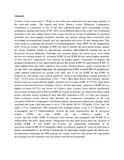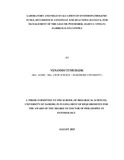| dc.description.abstract | Cowpea (Vigna unguiculata L. Walp) is one of the most important food and forage
legumes in the semi-arid tropics. The legume pod borer, Maruca vitrata (Fabricius)
(Lepidoptera: Crambidae) is considered as one of the most important insect pests
constraining cowpea production, causing yield losses of 20 – 80% across different parts
of the world. Use of chemical pesticides is the most widely known form of pest control on
cowpea. Exploitation of microbial pesticides has been gaining increased attention and
interest among those concerned with developing environmentally friendly and safe
approaches and tactics for pest management. This study aimed at evaluating the potential
of entomopathogenic fungi (EPF) for the management ofM. vitrata on cowpea. Screening
of EPF was done to identify the most potent isolates against M. vitrata. Fourteen isolates
of Metarhizium anisopliae (Metschnikoff) Sorokin and six of Beauveria bassiana
(Balsamo) Vuillemin were screened against first instar larvae, from which the best two
isolates namely M. anisopliae ICIPE 18 and ICIPE 69 that caused highest mortality of
91% and 81%, respectively were selected for further studies. Assessment of biomass and
propagule production in four liquid media showed that isolate ICIPE 69 outperformed
ICIPE 18, while Jenkins-Prior and APU1 ranked as best media. Thermotolerance studies
revealed that 25 oC and 30oC were optimal temperature for germination for ICIPE 18 and
ICIPE 69, respectively, while optimal temperature for growth were 30oC and 33 oC for
ICIPE 69 and ICIPE 18, respectively. All isolates were virulent against M. vitrata at all
temperatures causing mortality of 56.0 – 91.6% across all temperatures (15oC – 33oC).
Host plant effects were detected whereby insects raised on cowpea had the highest
mortality due to isolate ICIPE 18 (77.5%) while those reared on bean had the lowest
mortality (36.6%). On the other hand, virulence of ICIPE 69 was highest on beans
(95.7%), and lowest on Cajanus cajan. Cajanus cajan induced significantly fewer colony
forming units (CFU) for ICIPE 69. Fungal persistence was affected by plant, fungal
isolate, and time factors resulting in more than 90% reduction in CFU at 3 days post
spraying. Field evaluation results showed that Karate®, the commercial formulation of M.
anisopliae ICIPE 69 (Campaign®), and Nimbecidine®, significantly reduced pest damage
which translated into grain yield increment of up to 1254 Kg/ha (387%), 747kgs/ha
(231%), and 340 kg/ha (117%), respectively. This translated into marginal returns of up
to 5.7 (Karate®), 3.1 (Campaign®) and 1.2 (Nimbecidine®). Overall, the study
demonstrated that M. anisopliae isolates ICIPE 18 and ICIPE 69 are effective against M.
vitrata, and that isolate ICIPE 69 produced more biomass and propagules than ICIPE 18,
in Jenkins-Prior and APU1 liquid media. Temperature and host plant factors affect the
virulence of isolates ICIPE 18 and ICIPE 69. Overall, the commercial formulation of M.
anisopliae isolate ICIPE 69 (Campaign®) which was effective against M. vitrata in field
trials is hereby recommended as an effective biopesticide for protecting cowpea against
the insect pest. Incorporating Camapaign into IPM package for cowpea would not only
protect the crop against pest damage but also minimize risks associated with chemical
pesticides. | en_US |


